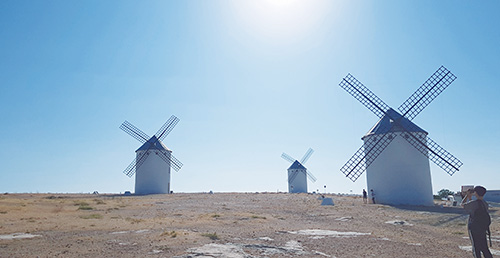To find the meaning of the popularity of Don Quixote, in La Mancha and Toledo
Most people may know “Don Quixote” of “Miguel de Cervantes.” Described as the greatest novel in literary history, Don Quixote is known as the world’s first modern novel and the second most frequently read book in the West, following the Bible. Then, how has Don Quixote, published in 1605, maintained its popularity for over 400 years?
 It is the windmill that remind us why Don Quixote mistook them for giants. /Photograph by You Hyeon-dong |
The linkage of various industries in the core of Don Quixote
Connection with many industries may be the reason that the novel Don Quixote is so popular among people until now. One example of this industry is the tourism industry. The main stage of the novel is La Mancha, where Don Quixote played a role as a famous tourist product. The windmills, which stand tall against the wide sky, are beautiful, but also remind us why Don Quixote mistook them for giants. If people think of windmills as giants, the wings that spin in the wind look like giants' wielding arms, which are threatening them.
Especially, the main reason why this place is famous for its tourist products is the excellent preservation of the windmills. Even though they are naturally modified and damaged over time, they remain in their past shape due to their excellent maintenance and repair techniques that make little difference from the original form. It gives a more vivid impression to imagine the corresponding scene of the novel.
The village of Campo de Criptana in La Mancha province had also be found several symbols related to Don Quixote. A statue of Don Quixote welcomes visitors first at the entrance to the village. The bronze-casted statue looks far from splendid and rather rugged, but it can rather feel more familiar to us in that respect. Inside the village, there is also a house with embroidered curtains related to Don Quixote hanging from the door. In front of the cathedral in the village stands a statue of Cervantes who has written the novel. The statue was likewise cast in bronze. It does not feel as rugged as the Don Quixote statue, but it is unique, with a knife in its waist and a book in one hand. People may think that the author and the knife do not match. However, the statue makes us feel like it is a symbol of an author’s image that he had a sharp satire like a blade through the book.
Another tourist city in Spain, Toledo, there is also a symbolic figure related to Don Quixote. Toledo Square features a stone bench with a tile engraved with Don Quixote-related paintings.
Spain’s official tourism agency also offers tours of places that serve as a background for Don Quixote. Active promotion and hosting of it by institutions are the reasons why the tourism industry has developed. Tourism is not the only thing associated with Don Quixote. Food culture is also closely related to Don Quixote. Some restaurants actually reproduce and sell these foods and some even hold a contest to recreate the foods that appear in the novel.
 It is the windmill that remind us why Don Quixote mistook them for giants. /Photograph by You Hyeon-dong |
People’s natural lifestyle at that time is placed in the novel
One of the characteristics of the novel Don Quixote is that the Spanish lifestyle of the time when it was written is naturally incorporated into the novel. One is the food culture that Don Quixote eats at the beginning of the novel that contains a bacon-filled egg dish named “duelos y quebrantos.” This food’s name means “pain and sorrow.”
Readers may ask here, “Why does the food name have this meaning?” If they read as follows, they will find the answer to the question. The Spanish government at the time had Christian pure-blooded ideas, and at the time pagans were persecuted. This is why the food name has a meaning like this. Therefore, if readers realized that a heathen such as a Muslim endured eating this food to hide his/her identity, readers can have another fun by having a perception from outside the novel.
In another episode, Sancho shares “Hamong and Wine” with people he met on the street in the novel. Hamong and Wine mean “free” here. In fact, people in Spain enjoyed eating Hamong and Wine in a free atmosphere.Through this naturally melted lifestyle in the novel, Don Quixote is also used as a good source for studying the lifestyle of the day.
The value we need to learn from Don Quixote
What value should people learn from this highly acclaimed Don Quixote? The answer is the courage to rise again and not to collapse even if they fail first. Everyone experiences numerous failures in their lives. Instead of being frustrated that they failed, they need the courage to constantly challenge themselves like “Don Quixote.”
The second is the tenacity of continuing to achieve the aim, which is a firm ideal. Don Quixote is treated like a madman in the novel, but he was credited for the patience. In the novel, his goal is to defeat the evil of the world, and raise the name of his own Lady, Princess Dolsinea.
The pursuit of such a firm ideal has given him an indelible impetus to his actions, even though he began his adventure at the age of 50. Although Don Quixote is treated as a madman, his spirit is still seen as an important value for us living in the present period.

